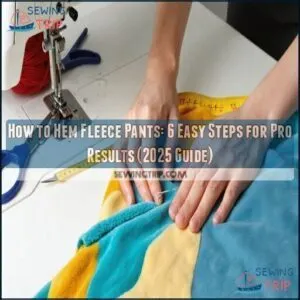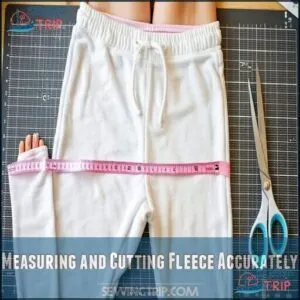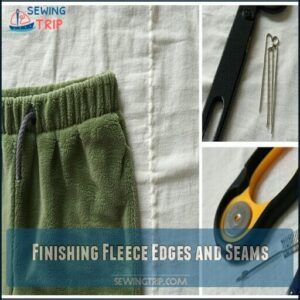This site is supported by our readers. We may earn a commission, at no cost to you, if you purchase through links.

First, try on your pants and fold them to your desired length. Pin the fold in place, then take them off. Measure from the fold to verify even hemming on both legs.
For fleece, you can simply cut along your marked line—it won’t fray! For a finished look, fold under ½ inch and stitch with a zigzag or stretch stitch.
Don’t pull the fabric while sewing or you’ll get waves. The right stitch makes all the difference between homemade-looking pants and professional results.
Table Of Contents
Key Takeaways
- Measure twice, cut once, and pin carefully to ensure a straight and even hem.
- Use a zigzag or stretch stitch to maintain flexibility and prevent thread breakage.
- Don’t stretch the fabric while sewing to avoid puckering or wavy seams.
- Fleece won’t fray, so you can create a simple or double-fold hem for a clean, professional finish.
Preparing Fleece for Hemming
You’ll need to prepare your fleece properly before hemming to guarantee professional-looking results that last.
While fleece doesn’t fray like other fabrics, taking time to measure accurately and create clean, straight edges with sharp scissors will make the entire hemming process much easier.
Choosing The Right Fleece Fabric
When selecting fleece fabric for your pants hemming project, fabric weight matters most.
Lightweight fleece works best for indoor wear, while heavyweight options provide extra warmth.
Consider the stretch factor—fabrics with 5-10% spandex offer comfortable movement without losing shape.
Examine texture options like smooth polar fleece, fuzzy sherpa, or plush minky based on your comfort preference.
Eco-conscious crafters can choose recycled polyester fleece that’s just as durable.
Remember to check fiber content labels—polyester provides durability while cotton blends add breathability.
The right fleece choice guarantees both comfort and successful hemming results.
Measuring and Cutting Fleece Accurately
For accurate fleece pants hemming, start with precision measurement—your gateway to perfect results.
Lay your fleece completely flat, removing all wrinkles before measuring. Use a reliable fabric measuring tape to mark your desired length, remembering to measure twice, cut once. A quality measuring tool is essential for accuracy.
Choose sharp fabric scissors or a rotary cutter for clean, straight edges. When marking, consider your hemming method and allow appropriate fabric for folding. For consistent results, measure from the waistband down, marking at identical points on both legs.
Removing Old Hems and Preparing Edges
Now that you’ve measured your fleece fabric with precision, it’s time to tackle those old hems!
To properly prepare your fleece pants for alteration:
- Gently work a seam ripper underneath stitches, cutting threads every inch for easier removal
- Remove any elastic bands carefully, setting them aside for reuse
- Smooth the edge with your fingers after removal, checking for any remaining threads
Despite fleece’s non-fraying nature, preparing clean edges guarantees your new hem will look professional. A straight cutting line creates the foundation for perfect pants repair every time!
Using Washable Markers for Hemming Lines
While removing old hems prepares your fleece for transformation, accurate marking creates the blueprint for your perfect pants length.
Washable markers are your best friends when drawing hemming lines on fleece fabric. Before tackling your favorite pants, always test your marker on a scrap piece to confirm it truly washes out.
For professional-looking results, remember these marking techniques:
- Use light pressure to prevent ink bleeding through your fleece fabric
- Draw continuous lines while keeping the fabric flat and smooth
- Mark on the wrong side of the fabric when possible
Different marker types work well on fleece – blue water-soluble pens, chalk markers, or even soap slivers in a pinch. When you’re finished, simply remove marks with a damp cloth or during washing.
Creating a New Hem on Fleece
You’ll transform those too-long fleece pants into a perfect fit with just a few simple steps and tools you already have at home.
Creating a new hem doesn’t require fancy equipment since fleece won’t fray when cut, making it one of the most forgiving fabrics for beginners to work with.
Folding and Pinning Fleece for Hemming
Folding and pinning forms the foundation of your fleece pants hemming journey.
Start with accurate folding by turning the raw edge up 1/2 inch, then fold again to create a double-fold hem that hides raw edges.
Place pins perpendicular to the fold every 2-3 inches, ensuring even alignment throughout.
For stretchy fleece, pin more frequently to prevent shifting during sewing.
Smooth the fabric as you go, eliminating any puckers or wrinkles that might create an uneven hem.
Remember, your pins are like little helpers holding everything in perfect position until you’re ready to stitch, which is a crucial step in achieving a professional-looking hemming journey.
Sewing a New Hem by Hand or Machine
With your pins securely in place, it’s time to transform those fleece edges into a polished hem. Whether you prefer hand stitching or machine sewing, both methods can deliver professional results.
For successful fleece hemming:
- Choose polyester thread that matches or complements your fleece color
- Select the right needle (ballpoint for machine, tapestry for hand sewing)
- Set your machine to a medium-length zigzag stitch or use a stretch stitch
- Test your tension settings on a scrap piece first
For machine settings, a slight zigzag prevents thread breakage when the fabric stretches. If you’re hand sewing, a simple running stitch works well for fleece pants. Consider exploring options for specialized fleece projects.
Remember, fleece doesn’t fray, so your hemming is more about creating a clean finish than preventing unraveling. Take your time—rushing through hemming is like trying to sprint through quicksand!
Using Elastic for a Stretchy Hem
Adding elastic into your fleece pants hem creates a snug yet comfortable finish that won’t ride up during the day. Choose the right elastic width—½ inch for subtle gathering or 1-inch for defined cuffs—based on your style preference.
Creating a proper casing requires folding the fabric edge twice with consistent tension control throughout. When sewing, select a zigzag or stretch stitch that allows the elastic to move freely without breaking your thread.
To guarantee a secure hold, consider the zigzag stitch technique for attaching elastic directly to the fabric. For best results, secure the elastic ends with a sturdy box stitch to prevent them from twisting inside the casing.
Test different elastic attachment methods on scraps first—your knees will thank you later! This step is crucial for achieving a comfortable finish and ensuring the elastic does not ride up during wear, providing a secure hold with the right elastic width.
Hemming Techniques for Different Fleece Types
While elastic creates a stretchy edge, different fleece types need unique hemming approaches.
Polar fleece works beautifully with a zigzag stitch that maintains stretch. Minky hemming requires gentle handling—use a longer stitch length to avoid crushing those soft fibers. Sherpa stitching benefits from a walking foot to manage thickness.
Weight matters! Lightweight recycled fleece needs finer needles, while heavyweight varieties demand sturdier equipment.
For fleece pants hemming, match your technique to the fabric’s personality. The right approach keeps your fleece edges looking professional every time, and it is crucial to use the right approach to maintain a professional look.
Hemming Stretchy Fleece Pants
You’ll need special care when hemming stretchy fleece pants to maintain their comfort and elasticity while creating a clean finish.
With the right techniques and tools, you can transform those too-long fleece bottoms into perfectly fitted pants that won’t bunch up at your ankles or lose their cozy stretch.
This will help you achieve a great fit and ensure the pants remain comfortable.
Understanding Stretchy Fleece Fabric
When working with stretchy fleece, you’re handling a fabric with personality all its own.
This versatile material combines comfort with function, making it perfect for pants that move with you.
Key characteristics to understand:
- Fabric Recovery determines how well it bounces back after stretching
- Weight Differences affect drape and warmth
- Texture Variations impact both appearance and feel
- Stretchy fleece contains spandex or elastane for flexibility
- Eco-Friendly Fleece options use recycled polyester
Remember, fleece fabric behaves differently than woven materials.
It’s like a dance partner—respect its natural stretch, and you’ll create hemmed pants with professional results every time.
Measuring and Marking Hem Lines on Stretchy Fleece
You’ll need eagle-eye precision when measuring and marking hem lines on stretchy fleece pants. Start by laying your pants flat on a work surface, then use a flexible tape measure and washable fabric marker to create consistent width markings.
Remember to account for the fabric’s natural give—stretchy fleece can distort if not measured properly. Double-check your measurements by gently pulling the material as you’d when wearing it. This prevents any uncomfortable surprises in your final fleece pants length.
To avoid puckering, consider using stabilizing tape before hemming. Don’t rush this step—accurate measurement now saves headaches later!
Sewing a Hem on Stretchy Fleece Pants
Your fleece pants’ comfort depends on how you sew that perfect hem.
Master these four simple steps:
- Fold the fabric edge 1-2 inches upward, creating a clean double-fold for durability
- Pin every few inches, keeping tension even across the stretchy material
- Choose a zigzag or stretch stitch on your machine to maintain elasticity
- Sew slowly around the leg, removing pins as you go
Tips for Hemming Stretchy Fleece Without Losing Elasticity
Now that you’ve sewn your hem, let’s make sure it stretches as well as your pants do. Maintaining elasticity when hemming fleece pants isn’t rocket science—it’s all about the right approach.
Your stitch selection makes all the difference. A narrow zigzag stitch preserves the stretch while keeping things secure.
- Use a walking foot to feed fabric evenly and prevent unwanted rippling
- Select elastic thread that moves with the fabric for ultimate flexibility
- Adjust your tension settings lower to avoid tight, restrictive seams
- Keep hem width consistent—around 1⁄2 inch works well for most fleece pants
Don’t test your hem when it’s fresh off the machine. Give it a quick steam first to help the stretchy fleece return to its natural state. Your pants will thank you!
Finishing Fleece Edges and Seams
You’ll love how the right edge finish can transform your fleece pants from homemade to store-bought quality in minutes.
Even though fleece doesn’t fray, adding techniques like turned-under edges, ribbing, fringe, or professional seaming will give your cozy pants that perfect, polished look.
Turning Under Edges for a Simple Finish
After mastering stretchy fleece pants, let’s explore the simplest way to finish your hems.
Turning under edges creates a clean finish that’s perfect for beginners. Simply fold your fleece once and stitch for a no-fuss hem that won’t unravel.
| Fold Type | Stitch | Result |
|---|---|---|
| Single fold | Straight | Quick, minimal bulk |
| Double-fold | Zigzag | Extra secure, hidden raw edge |
| Rolled edge | Stretch | Flexible, athletic look |
Adding Ribbing for a Polished Look
Adding ribbing to your fleece pants creates that professional, store-bought finish you’ve been dreaming about.
When selecting ribbing fabrics, choose options that complement your fleece fabric’s weight and stretch.
Here’s how to attach ribbing for perfect cuffs and waistband options:
- Cut ribbing strips 15% shorter than your hem circumference
- Pin ribbing to fleece with right sides together
- Stretch ribbing slightly while sewing with a zigzag stitch
- Fold ribbing over raw edge and topstitch for durability
- Steam press for a crisp, polished look
Creating Fringe for a Casual Edge
While ribbing offers elegance, fringe brings playful personality to your fleece pants. Creating this casual edge is simpler than you might think.
- Cut evenly spaced slits (1-2 inches deep) along the hem using sharp fabric scissors to prevent unwanted stretching.
For extra flair, try knotting techniques like twisted fringe or adding decorative accents such as small beads at the ends. Thicker fleece creates fuller fringe, while lighter fabrics produce delicate wisps.
When hemming fleece pants, this DIY alteration instantly transforms basic bottoms into statement pieces. I’ve found beaded fringe turns ordinary joggers into conversation starters at casual gatherings!
Seaming Fleece for a Professional Finish
Your seam’s success hinges on precise technique when creating professional-looking fleece pants.
Use a 1/2-inch seam allowance paired with the right stitch for flexibility and durability.
Understanding fleece fraying resistance is key to a clean finish.
| Seam Types | Best Application |
|---|---|
| Flat Seam | Reduces bulk |
| French Seam | Elegant finish |
| Serged Edge | Quick, clean look |
| Overlapped Seam | Extra strength |
| Bound Edge | Most professional |
Don’t forget to adjust your tension settings lower for fleece’s thickness and use the right seam allowance for a clean finish with professional-looking results.
Sewing Fleece Pants for Kids
You’ll save time and money by creating cozy fleece pants for your growing kids instead of constantly buying new ones.
With soft, non-fraying fabric and simple techniques, you can customize the perfect pair that’ll stand up to playground adventures while keeping little legs warm.
Gathering Supplies for Sewing Fleece Pants
Before starting your fleece pants project for the little ones, you’ll need these essential supplies:
- Sharp fabric scissors for clean, precise cuts
- Sewing machine with ballpoint or universal needles
- Flexible measuring tape for accurate sizing
- Colorful sewing pins that won’t damage fleece
- Quality polyester thread that stretches with the fabric
- Pattern paper or old pants for tracing
For best results, make certain you have exceptionally sharp blades to avoid snags.
With these tools ready, you’re set for sewing success!
Measuring and Cutting Fleece for Kids’ Pants
Now that you’ve gathered your supplies, let’s focus on getting those measurements just right for your little one’s fleece pants.
Accurate measurements are the foundation of perfectly fitted kids’ fleece pants.
Here’s how to nail it:
- Lay a well-fitting pair of pants on your folded fleece, aligning with the fabric’s stretch direction
- Add 1-2 inches to the length for growth room and hemming allowance
- Trace around the pants with washable markers, leaving extra room at the waistband
Use sharp scissors and cut with confident, smooth strokes.
Remember, careful cutting now means less frustration later, and it’s essential for getting those measurements just right.
Sewing Leg Seams and Hemming Fleece Pants
Now that your pieces are cut, it’s time to join them together! Place right sides facing each other for strong leg seams when sewing fleece pants.
Pin carefully before stitching.
| Seam Component | Best Practice for Durability |
|---|---|
| Stitch Selection | Zigzag (width 2.5) for stretch |
| Seam Allowance | ½ inch for proper leg fit |
| Hem Depth | 1-2 inches turned under once |
| Needle Type | Ballpoint to prevent damage |
Press seams flat to reduce bulk, then fold and pin your hem. For a professional finish, stitch ¼ inch from the folded edge.
Adding Elastic Waistbands for Comfort
The elastic waistband is the crown jewel of your kid’s fleece pants project.
Measure your child’s waist and subtract an inch for the perfect Band Tension.
Create a Casing Options by folding the top edge down 1¼ inches and stitching, leaving a small opening.
Thread your elastic through using a safety pin, then secure ends with Stitch Techniques like a zigzag for durability.
To achieve a snug fit, remember to subtract a few inches from the waist measurement when cutting the elastic.
For Comfort Customization, choose wider elastic (¾-1 inch) that won’t twist or dig into little tummies during playground adventures.
Common Mistakes and Troubleshooting
You’ll run into a few bumps along your fleece hemming journey, but don’t worry – even seasoned sewers sometimes end up with wavy edges or stretched-out fabrics.
In this section, we’ll tackle common fleece hemming mistakes and show you quick fixes that’ll save your pants project from becoming a frustrating pile in the corner, with the goal of making it a successful and frustrating-free experience.
Avoiding Common Hemming Mistakes on Fleece
Hemming fleece pants can trip up even experienced sewers.
Watch for these common pitfalls to achieve professional results:
- Uneven hems: Measure twice and cut once to avoid the dreaded zigzag bottom edge.
- Fabric slippage: Secure your fleece with plenty of pins to prevent shifting during sewing.
- Skipped stitches: Use the right needle selection—ballpoint needles work best for fleece.
- Puckered seams: Adjust your tension settings to accommodate fleece’s thickness.
Don’t let these mistakes ruin your cozy fleece project! With proper preparation and technique, you’ll create smooth, professional hems that’ll last through countless washes and wears.
Troubleshooting Hemming Issues on Fleece
After spotting common mistakes, let’s solve those frustrating hemming issues that pop up when working with fleece pants.
When your machine produces skipped stitches on your fleece fabric, switch to a ballpoint needle and adjust your thread tension. This simple change prevents the needle from piercing rather than sliding between fleece fibers.
Dealing with puckered seams? Loosen your machine’s tension and try a longer stitch length. For persistent fabric slippage, attach a walking foot to your machine—it’s worth every penny for handling stretchy fleece pants.
Thread breaking mid-seam? Clean your machine’s tension discs and use quality polyester thread designed for stretch fabrics.
To prevent fleece from stretching while hemming, use fabric clips instead of pins and sew with even, gentle pressure. A stretch stitch maintains elasticity in your finished hems without warping.
Fixing Uneven Hems and Seams on Fleece
When uneven hems ruin your fleece pants, don’t panic! Grab your seam ripper and carefully remove those crooked stitches.
Fleece’s unique properties make it forgiving during fixes. Re-pin with precise alignment, ensuring fabric doesn’t shift during sewing.
To correct puckering, adjust your machine’s tension and switch to a stretch stitch. Remember that fleece pants fixes work best with a walking foot to prevent fabric shifting.
Preparing for Future Hemming Projects on Fleece
Now that you’ve fixed those tricky uneven hems, let’s set you up for smooth sailing on future fleece projects.
Smart preparation makes hemming fleece pants a breeze. Here’s your game plan:
- Create a dedicated "fleece station" with tools organized by frequency of use
- Store fabric rolls horizontally to prevent stretching and creasing
- Keep a "fleece journal" noting which techniques worked best for different weights
- Pre-wash fleece fabric before project planning
- Collect pattern pieces specifically sized for stretchy materials
Your sewing machine and skills will thank you for this smart preparation, which will make hemming fleece pants a breeze.
Frequently Asked Questions (FAQs)
Can You Hem a fleece shirt?
Imagine tweaking a cozy blanket into a perfect shirt—yes, you can hem a fleece shirt.
Use a zigzag stitch or hem tape for stretch, ensuring the fabric stays soft, flexible, and polished.
How do you Hem pants?
To hem pants, fold the fabric to your desired length, pin it for accuracy, and sew using a zigzag or stretch stitch.
For no-sew options, use hem tape or fabric glue. Stay precise!
What is the best tape for hemming Fleece?
The best tape for hemming fleece is double-sided fabric tape, designed for stretch materials.
It’s easy to use, strong enough to hold folds in place, and perfect for projects where sewing isn’t your first choice!
Can You Hem your own pants?
Of course, you can hem your own pants!
With fabric scissors, pins, and a sewing machine (or needle), you’ll get a custom fit.
Measure twice, cut once—precision is key for a polished finish!
How to hem sweatpants?
Fixing your sweatpants is like giving them a quick tune-up.
Cut to the desired length, fold the edge twice, and sew with a zigzag stitch.
It’s simple, keeps them comfy, and looks polished!
How do you Hem a trouser?
Start by measuring and marking your desired length.
Fold the fabric twice for a clean edge, then pin it in place.
Use a zigzag stitch for elasticity. Trim excess fabric carefully for a polished finish.
Can you hem a fleece?
Measure twice, cut once—that’s the golden rule.
You can hem fleece easily since it won’t fray.
Use sharp scissors and a zigzag stitch or stretchy thread.
Hemming adds polish, perfect for fleece projects.
How to hem velvet trousers?
To hem velvet trousers, fold the edge inward twice for a clean finish.
Pin carefully to avoid slipping, then use a sewing machine with a zigzag stitch or hem tape for a polished, professional look.
What Hem do you use for dress pants?
A blind hem works best for dress pants, keeping the finish clean and professional.
It’s nearly invisible on the outside, adding polish without distracting.
Use matching thread, sharp needles, and fold carefully for precision.
Can You Hem pants?
Yes, you can hem pants easily.
Folding the fabric, pinning, and stitching with a zigzag or stretch stitch works wonders.
Hemming but also customizes length and keeps pants looking neat and fitting comfortably.
Conclusion
Hemming fleece pants might feel like rocket science at first, but it’s really just about preparation, patience, and the right stitches.
Measure carefully, cut confidently—fleece won’t fray—and choose a zigzag or stretch stitch to keep the hem clean and flexible.
Don’t forget to avoid stretching the fabric while sewing for smooth results.
Whether you’re fixing pants for yourself or the kids, mastering how to hem fleece pants will save time and money while upping your DIY game!


















